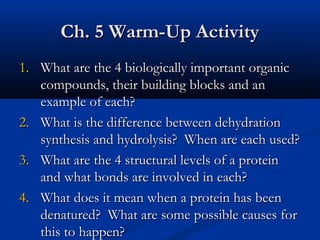
AP Bio Chapter 5 (Carbohydrates)
- 1. Ch. 5 Warm-Up Activity 1. What are the 4 biologically important organic compounds, their building blocks and an example of each? 2. What is the difference between dehydration synthesis and hydrolysis? When are each used? 3. What are the 4 structural levels of a protein and what bonds are involved in each? 4. What does it mean when a protein has been denatured? What are some possible causes for this to happen?
- 2. Chapter 5 The Structure and Function of Large Biological Molecules
- 3. You Must Know • • • • • The role of dehydration synthesis in the formation of organic compounds and hydrolysis in the digestion of organic compounds. How to recognize the 4 biologically important organic compounds (carbs, lipids, proteins, nucleic acids) by their structural formulas. The cellular functions of all four organic compounds. The 4 structural levels of proteins How proteins reach their final shape (conformation) and the denaturing impact that heat and pH can have on protein structure
- 4. Monomers •Small organic •Used for building blocks of polymers •Connects with condensation reaction (dehydration reaction) Polymers Macromolecules •Long molecules of •Giant molecules monomers •2 or more polymers •With many identical or bonded together similar blocks linked by covalent bonds ie. amino acid peptide polypeptide protein smaller larger
- 5. Dehydration Reaction (Condensation Reaction) Hydrolysis Make polymers Breakdown polymers Monomers Polymers Polymers Monomers A + B AB AB A + B + + H2O + H2O +
- 7. I. Carbohydrates • Fuel and building material • Include simple sugars (fructose) and polymers (starch) • Ratio of 1 carbon: 2 hydrogen: 1 oxygen or CH2O • • • monosaccharide disaccharide polysaccharide Monosaccharides = monomers (ie. glucose, ribose) Polysaccharides: Differ in Storage (plants-starch, animals-glycogen) Structure (plant-cellulose, arthropod-chitin) position & orientation of glycosidic linkage
- 8. The structure and classification of some monosaccharides
- 9. Linear and ring forms of glucose
- 10. Examples of disaccharide synthesis
- 11. Storage polysaccharides of plants (starch) and animals (glycogen)
- 12. Structural polysaccharides: cellulose & chitin (exoskeleton)
- 13. II. Lipids A. Fats (triglyceride): store large amounts of energy (2x carbohydrates), cushions organs and insulates body Glycerol + 3 Fatty Acids saturated, unsaturated, polyunsaturated A. Steroids: cholesterol and hormones Steroids B. Phospholipids: cell membrane hydrophilic head, hydrophobic tails creates bilayer to form cell membrane Hydrophilic head Hydrophobic tail
- 14. Ester linkage: between OH & COOH Long HC chain: -Polar or non-polar? -Hydrophilic or hydrophobic?
- 15. Saturated Unsaturated Polyunsaturated “saturated” with H Have some C=C, result in kinks In animals In plants Solid at room temp. Liquid at room temp. Eg. butter, lard Eg. corn oil, olive oil
- 16. Steroids include cholesterol (shown above) which is the building block for steroid hormones and component of cell membranes
- 17. The structure of a phospholipid
- 18. Hydrophobic/hydrophilic interactions make a phospholipid bilayer
- 19. Overview of protein functions
- 20. Overview of protein functions
- 21. Proteins: polymers made of amino acid monomers
- 22. III. Proteins Four Levels of Protein Structure: 1. Primary Amino acid (AA) sequence 20 different AA’s peptide bonds link AA’s
- 23. Four Levels of Protein Structure (continued) 2. Secondary Gains 3-D shape (folds, coils) by H-bonding Alpha (α) helix, Beta (β) pleated sheet
- 24. Four Levels of Protein Structure (continued) 3. Tertiary Bonding between side chains (R groups) of amino acids H & ionic bonds, disulfide bridges, van der Waals interactions
- 25. Four Levels of Protein Structure (continued) 4. Quaternary 2+ polypeptides bond together
- 26. amino acids polypeptides protein Bonding (ionic & H) can create asymmetrical attractions
- 27. Chaperonins assist in proper folding of proteins
- 28. • • Protein structure and function are sensitive to chemical and physical conditions Unfolds or denatures if pH and temperature are not optimal
- 29. change in structure = change in function
- 30. IV. Nucleic Acids Function: carry hereditary info DNA •Double stranded helix • N-bases: A, G, C, Thymine •Stores hereditary info •Longer/larger •Sugar: deoxyribose RNA •Single stranded • N-bases: A, G, C, Uracil •Carry info from DNA to ribosomes •tRNA, rRNA, mRNA, RNAi •Sugar: ribose
- 31. Nucleotides: monomer of DNA/RNA 3 parts: -nitrogen base -pentose sugar -ribose -deoxyribose -P04 group
- 32. phosphate Nucleotide Nitrogenous base Purines 5-C sugar A–T G–C Pyrimidines •Adenine •Guanine •Cytosine •Thymine (DNA) •Uracil (RNA) •Double ring •Single ring
- 35. Nucleic polymer • Backbone Sugar to PO4 bond Phosphodiester bond • • • • • new base added to sugar of previous base Polymer grow in one direction N bases hang off the sugar-phosphate backbone
- 36. Pairing of nucleotides • Nucleotides bond between DNA strands H bonds Purine :: Pyrimidine A :: T • • • • 2 H bonds G :: C • • 3 H bonds
- 37. DNA RNA protein: a diagrammatic overview of information flow in a cell.